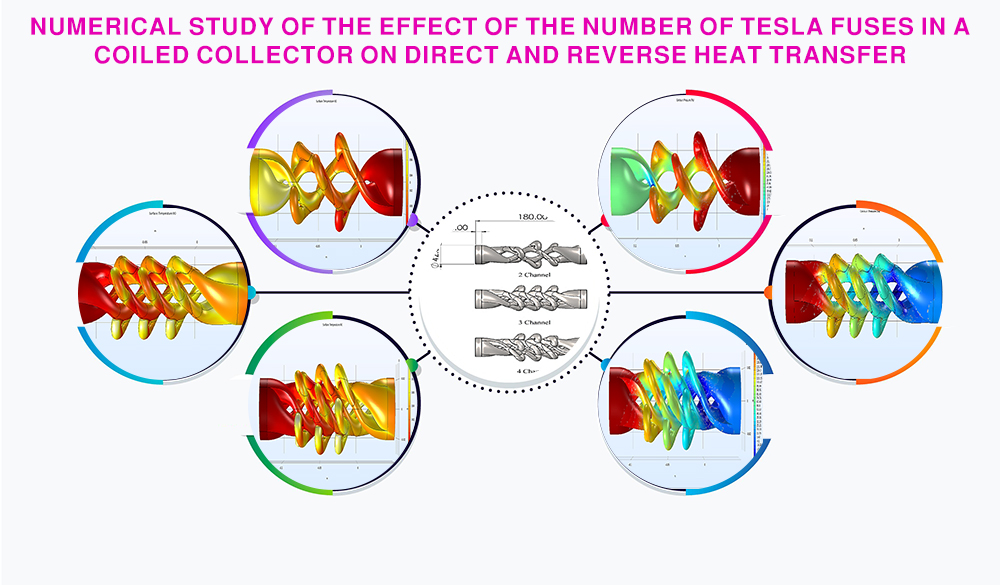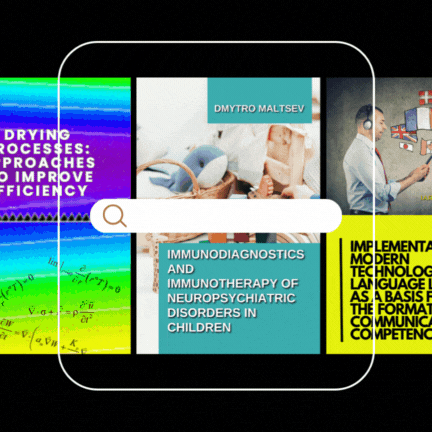Identifying of the effect of the number of tesla fuses in a coiled collector on direct and reverse heat transfer
DOI:
https://doi.org/10.15587/1729-4061.2022.266213Keywords:
tesla valve, COMSOL multiphysics, natural circulation loop, heat and mass transferAbstract
Work was done on the Tesla valve in this study with a coiled and three-dimensional shape, where a different number of these channels and a direct and reverse flow turbine were used to compare the changes that obtain the amount of pressure and temperatures. With the conception of the technology of transferring heat energy in various heat exchangers, it became necessary to develop our technologies that increase the transmission of this energy, and we must refer to the inventions that contributed to the development of the heat transfer system and the three energy laws. They contributed to the development of some mechanical systems, where the Tesla valve is considered one of the valves that have two directions of flow, the first is direct, in which the pressure value is low, and the other is reverse, which occurs when movement is disturbed due to the direction of the channel in which it can be used. This concept can be used to improve heat transfer.
Where the results establish that an increase in the number of channels positively affects the pressure and thus gives more outlets for the passage of water, a study has shown. In the case of four channels an exit temperature of 304.14 K was obtained, which is the highest temperature reached in cases where the direction of flow is direct. The pressure value was in the case in which the channel is a quadrilateral, and the pressure value reached 209 pa. This data are useful and important because the direct exit score has reached 305.74 K for the Tesla valves, which are designed to give enough time for the heat to transfer to the water. The main principle of the Tesla valve is the reverse direction, which works to obstruct the movement of the fluid, and thus increases the pressure and reduces the velocity of the flow
References
- Wang, X., Yang, L., Sun, F. (2021). CFD analysis and RSM optimization of obstacle layout in Tesla micromixer. International Journal of Chemical Reactor Engineering, 19 (10), 1045–1055. doi: https://doi.org/10.1515/ijcre-2021-0087
- Wahidi, T., Yadav, A. K. (2021). Instability mitigation by integrating twin Tesla type valves in supercritical carbon dioxide based natural circulation loop. Applied Thermal Engineering, 182, 116087. doi: https://doi.org/10.1016/j.applthermaleng.2020.116087
- Kubar, A. A., Cheng, J., Kumar, S., Liu, S., Chen, S., Tian, J. (2021). Strengthening mass transfer with the Tesla-valve baffles to increase the biomass yield of Arthrospira platensis in a column photobioreactor. Bioresource Technology, 320, 124337. doi: https://doi.org/10.1016/j.biortech.2020.124337
- Monika, K., Chakraborty, C., Roy, S., Sujith, R., Datta, S. P. (2021). A numerical analysis on multi-stage Tesla valve based cold plate for cooling of pouch type Li-ion batteries. International Journal of Heat and Mass Transfer, 177, 121560. doi: https://doi.org/10.1016/j.ijheatmasstransfer.2021.121560
- Niu, Z., Shengming, X., jiangang, J., Jun, Z. (2021). Design and Optimization of Strength type Negative Pressure Suction Force Pluck Port based on Tesla Valve. doi: https://doi.org/10.21203/rs.3.rs-213596/v1
- Yao, Y., Zhou, Z., Liu, H., Li, T., Gao, X. (2021). Valveless Piezoelectric Pump with Reverse Diversion Channel. Electronics, 10 (14), 1712. doi: https://doi.org/10.3390/electronics10141712
- Shinde, N., Salema, Z., Sakarwala, B. (2020). An Investigation of Non-Return Valves as Possible Sources of Pump Failure and A Comparative Analysis with Tesla Valves. International Journal of Engineering Research & Technology, 9, 71–80.
- Cao, Z., Zhao, T., Wang, Y., Wang, H., Zhai, C., Lv, W. (2020). Novel fluid diode plate for use within ventilation system based on Tesla structure. Building and Environment, 185, 107257. doi: https://doi.org/10.1016/j.buildenv.2020.107257
- Wahidi, T., Chandavar, R. A., Yadav, A. K. (2020). Stability enhancement of supercritical CO2 based natural circulation loop using a modified Tesla valve. The Journal of Supercritical Fluids, 166, 105020. doi: https://doi.org/10.1016/j.supflu.2020.105020
- Jin, Z., Qiu, C., Jiang, C., Wu, J., Qian, J. (2020). Effect of valve core shapes on cavitation flow through a sleeve regulating valve. Journal of Zhejiang University-SCIENCE A, 21 (1), 1–14. doi: https://doi.org/10.1631/jzus.a1900528
- Abdelwahed, M., Chorfi, N., Malek, R. (2019). Reconstruction of Tesla micro-valve using topological sensitivity analysis. Advances in Nonlinear Analysis, 9 (1), 567–590. doi: https://doi.org/10.1515/anona-2020-0014
- Holzapfel, G. A., Linka, K., Sherifova, S., Cyron, C. J. (2021). Predictive constitutive modelling of arteries by deep learning. Journal of The Royal Society Interface, 18 (182), 20210411. doi: https://doi.org/10.1098/rsif.2021.0411
- Khudov, H., Makoveichuk, O., Khizhnyak, I., Oleksenko, O., Khazhanets, Y., Solomonenko, Y. et al. (2022). Devising a method for segmenting complex structured images acquired from space observation systems based on the particle swarm algorithm. Eastern-European Journal of Enterprise Technologies, 2 (9 (116)), 6–13. doi: https://doi.org/10.15587/1729-4061.2022.255203
- Gorbenko, I., Ponomar, V. (2017). Examining a possibility to use and the benefits of post-quantum algorithms dependent on the conditions of their application. Eastern-European Journal of Enterprise Technologies, 2 (9 (86)), 21–32. doi: https://doi.org/10.15587/1729-4061.2017.96321
- Sakan, K., Nyssanbayeva, S., Kapalova, N., Algazy, K., Khompysh, A., Dyusenbayev, D. (2022). Development and analysis of the new hashing algorithm based on block cipher. Eastern-European Journal of Enterprise Technologies, 2 (9 (116)), 60–73. doi: https://doi.org/10.15587/1729-4061.2022.252060

Downloads
Published
How to Cite
Issue
Section
License
Copyright (c) 2022 Hasan Majdi, Mustafa Altalib, Ali Abdullah, Waleed Abbas, Omar Hamid, Hussein Ibrahim

This work is licensed under a Creative Commons Attribution 4.0 International License.
The consolidation and conditions for the transfer of copyright (identification of authorship) is carried out in the License Agreement. In particular, the authors reserve the right to the authorship of their manuscript and transfer the first publication of this work to the journal under the terms of the Creative Commons CC BY license. At the same time, they have the right to conclude on their own additional agreements concerning the non-exclusive distribution of the work in the form in which it was published by this journal, but provided that the link to the first publication of the article in this journal is preserved.
A license agreement is a document in which the author warrants that he/she owns all copyright for the work (manuscript, article, etc.).
The authors, signing the License Agreement with TECHNOLOGY CENTER PC, have all rights to the further use of their work, provided that they link to our edition in which the work was published.
According to the terms of the License Agreement, the Publisher TECHNOLOGY CENTER PC does not take away your copyrights and receives permission from the authors to use and dissemination of the publication through the world's scientific resources (own electronic resources, scientometric databases, repositories, libraries, etc.).
In the absence of a signed License Agreement or in the absence of this agreement of identifiers allowing to identify the identity of the author, the editors have no right to work with the manuscript.
It is important to remember that there is another type of agreement between authors and publishers – when copyright is transferred from the authors to the publisher. In this case, the authors lose ownership of their work and may not use it in any way.









